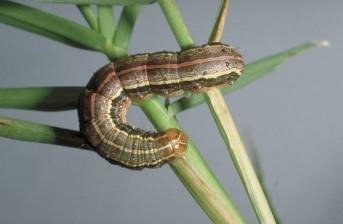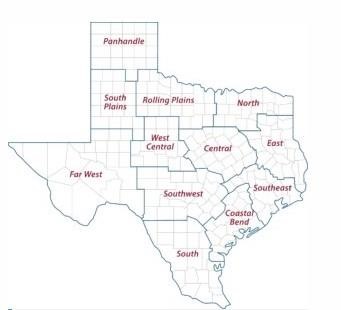Texas forage producers are facing high fertilizer prices, but Texas A&M AgriLife Extension Service experts do not expect they will face an early outbreak of fall armyworms.
 Fall armyworms can be devastating to hayfields and pastures due to their appetite for green grass crops. (Texas A&M AgriLife photo by Bart Drees)
Fall armyworms can be devastating to hayfields and pastures due to their appetite for green grass crops. (Texas A&M AgriLife photo by Bart Drees)David Kerns, Ph.D., AgriLife Extension state integrated pest management specialist and professor in the Department of Entomology, said recent weather has not created conditions for the early migration of the devastating pest experienced in 2021.
Populations typically build following large rain events and cooler weather. But Kerns said there is no indication that armyworm populations are building in southern areas of the state following recent weather systems that dropped temperatures and delivered moisture.
Fall armyworms’ name is indicative of their active season, but cool, wet weather can trigger outbreaks, Kern said. Populations of armyworms, which are extremely damaging to forage production, typically begin increasing sometime between July and September.
“Fall armyworms typically build up in southeastern Texas, and the moths move northward throughout the eastern half of the state,” he said. “Last year, with all the spring and summer rains, that buildup occurred earlier than usual, but conditions are much drier this year despite the recent storm fronts.”
No reports of armyworms so far
Fall armyworms are green with brown or black colorations and can be identified by the white inverted Y on their head. They can grow up to 1 inch in length when mature.
The pest got its name because they appear to march army-like across hay fields, consuming the grass in their path.
Armyworm moths can lay up to 2,000 eggs that hatch in two to three days, according to a 2019 report by Allen Knutson, Ph.D., AgriLife Extension entomologist, retired.
Vanessa Corriher-Olson, Ph.D., AgriLife Extension forage specialist, Overton, said there are four to five generations that move throughout the state per growing season. They typically move north from Mexico and South Texas as temperatures warm in the spring. Generations will push further north into midwestern states, but moths and larvae remain present throughout the state.
Drier, hotter conditions slow their life cycles, Corriher-Olson said. Moths lay fewer eggs and caterpillar growth is slowed. But rainfall and cooler temperatures can trigger major infestations when local populations, new hatches and migrating moths descend on areas with quality food sources.
Corriher-Olson said continued drier conditions overall in southern parts of the state are likely to curb any early issues forage producers may have experienced in 2021.
“I have not received any reports or phone calls, and that tells me populations in areas where the armyworm migration begins have not reached any level of concern,” she said.
No problem until there is a problem
Corriher-Olson said producers typically react to fall armyworm outbreaks when they occur, which has led to product availability issues during the pandemic. She noted, however, that she had not received any reports about insecticide shortages to date.
“Many producers take a reactionary approach to armyworms because of the expense,” she said. “Some producers may have products on hand that are left over from last year, but most are going to be monitoring the situation to their south and plan accordingly.”
Kerns said conditions may not be shaping up for armyworms at this point in the forage production season, but producers with Sudan grass, hay grazer and other forages related to sorghum should be on the lookout for sorghum aphids, also known as sugarcane aphids.
While armyworms prefer wetter, cooler weather, sorghum aphids prefer hot, dry conditions, he said. There have been reports of the aphids in grain sorghum fields in South Texas.
Aphids feed on leaves and leave a sap that further damages the plant, and major infestations can greatly impact forage yields.
Corriher-Olson said forage pests like fall armyworms and aphids are always a threat to producers’ bottom lines, but yield losses could magnify their impact on budgets due to higher input costs, especially fertilizer applications.
Many forage producers are forgoing or reducing fertilizer applications, which could impact where infestations build, she said. Fall armyworms will settle on any green pasture, but they prefer lush, fertilized forages.
“Fertilized fields are more at risk to be damaged,” she said. “So, when it comes to armyworms, we don’t want to see a producer spend money to produce quality forage and have armyworms destroy it.”
AgriLife Extension district reporters compiled the following summaries:
 A map of the 12 Texas A&M AgriLife Extension districts.
A map of the 12 Texas A&M AgriLife Extension districts.ROLLING PLAINS
Rainfall amounts were from 1.5-3 inches. The rains helped the soil moisture profile, but more rain was needed to fill stock tanks. There was very little green grass in pastures. Wheat harvest continued in the little bit of wheat worth combining. Yield reports ranged from 3-25 bushels per acre. Supplemental hay feeding of cattle continued.
COASTAL BEND
Southern parts of the area reported showers that produced trace amounts to 2 inches of rain. Crops with irrigation looked good, but dryland producers were concerned about crop losses. Cotton benefitted the most from rain, but more moisture will be needed to see good yields. Corn and grain sorghum were drying down and any moisture would probably only help with the kernel weight. Rangeland and pastures showed a slight color change with rain, but not much growth occurred, and conditions remained poor to fair. Livestock were still in a decline and receiving supplemental feed. Hay supplies were dwindling. More cattle producers were weaning early and culling out poor producing cows. Cattle market prices remained high.
EAST
Recent rains helped, but soils dried quickly. Pasture and rangeland conditions were fair. Subsoil and topsoil conditions were short to adequate. Hay production continued. Yields were much lower than normal as producers reduced fertilizer applications due to higher input costs. Harrison County reported problematic fly populations. Livestock were in fair to good condition.
SOUTH PLAINS
Producers received another significant rainfall shower this week across the county. Rainfall totals ranged from 0.5 inches to 2 inches. Some large hail was also mixed with the heavier rain. Cooler temperatures helped conditions. Rain was in the forecast. Cotton planting was in full swing with about 80% of acres planted so far. More rain will be needed for decent cotton, corn and sorghum yields. Pumpkin farmers started planting. Cattle were being supplementally fed. The recent rainfall helped pastures a little.
PANHANDLE
Soil moisture conditions were very short to short. Recent rains helped irrigated crops like wheat, corn and cotton some. Earlier planted corn was up and growing, but some silage corn plantings were still on hold. Cotton was already planted or going in, but producers were not optimistic about yields. Rangeland and pasture conditions improved, but much more rain will be needed to sustain a green-up. Overall, rangeland and pasture conditions remained poor, and crop conditions were poor to fair.
NORTH
Soil moisture ranged from adequate to short. Warmer temperatures and higher wind speeds dried up soil moisture. Corn, cotton and soybeans were doing well. Early planted corn was tasseling. The wheat harvest began, and fields looked good. No widespread insect or disease pressure was reported. Pasture and rangeland conditions were fair to good and had improved slightly following recent rainfall. The first hay harvests of Bermuda grass, ryegrass, Bahia grass or oats were cut and rolled without issue this year. This was the first early forage harvest in the past few years not delayed by rainfall or wet conditions. Cattle were in good to excellent condition. Horn and stable flies were increasing significantly, and horseflies and deerflies were worsening. Spring calves appeared to be gaining well. Supplemental feeding continued for livestock and wildlife, and forage quality looked poor. Rainfall will be necessary for continued forage production. Some hay producers were considering transitioning pastures to native forage production due to lack of rain and increased fertilizer costs.
FAR WEST
Weather was variable. A cold front dropped temperatures into the 40s and brought rainfall, hail and dust storms that took visibility to zero, but temperatures quickly returned to the 90s. A very narrow band of storms left trace amounts of rain up to 1.5 inches. Hail damage to farm equipment, barns, trees and residences was severe. Emerged cotton was hailed out. Cotton, especially Pima fields, looked good in other areas. Corn continued to make progress, but heat was starting to take its toll. Melons looked good and were making good progress. Pecan trees were coming along nicely and set a good crop. Some pecan nut casebearer pressure was reported. Alfalfa looked decent. Pastures remained completely bare. Cattle conditions continued to worsen, and some ranchers completed weaning.
WEST CENTRAL
Thunderstorms delivered from 1.5-3 inches of rainfall to most areas. Forages perked up with the moisture, but temperatures in the 90s and windy days could impact moisture retention. Some farmers harvested wheat last week, but yields were poor. Cotton outlooks were looking slim as well. Herd liquidation was slowly happening. Some producers with hay chose to feed through drought, but many were selling off their herds. An ongoing wildfire near Abilene was under control, but not before it burned 10,900 acres.
SOUTHEAST
Heavy rains helped soil moisture levels. Some hay was cut, and rice was fertilized. Forages were growing and producers in several areas cut their first hay crop with no pests reported. Rains slowed crop planting in some areas. Rice planting was not complete. Some areas remained dry and reported declining pasture, rangeland and crop conditions. Rangeland and pastures ranged from very poor to excellent condition. Soil moisture levels were short to surplus.
SOUTHWEST
Some areas received 0.75-3 inches of rain. The rainfall helped alleviate the drought stress for crops that survived to this point. Hot temperatures persisted and pastures looked overgrazed. Wheat and oat harvests were complete with below-average yields reported. Irrigated corn looked good, and cotton was doing well. Producers eased up on supplemental feeding due to the recent rains, but pasture conditions continued to decline in drier areas. Mesquite spraying was underway. Diet supplementation continued for livestock and wildlife, and forage production looked poor. Irrigated hay fields were in good condition.
SOUTH
Moisture levels in northern areas were very short, while eastern and western areas reported short to adequate soil moisture. Southern areas reported adequate to surplus moisture. Most areas reported rainfall with amounts ranging from 0.3-8 inches. Pastures and rangelands responded well to the moisture. Livestock conditions were improving and producers were decreasing supplemental feed. Cattle prices remained strong. Cattle producers in drier areas continued to provide supplemental feed to maintain body condition scores. Producers who planted hay grazer before the rains were expecting good growth. Significant rain missed croplands in northern parts of the district. Row crops and forages in areas that received rain were expected to improve significantly. Irrigated crops like watermelons, cantaloupes and Bermuda grass looked good. Cotton was expected to respond well to the moisture. Flooding and hail damaged some crops. Hail damaged around 5,000 acres of grain, sesame, sunflowers, watermelons and corn. Sorghum aphid pressure increased, and weeds were becoming an issue as fields were too wet to spray.
Source : tamu.edu